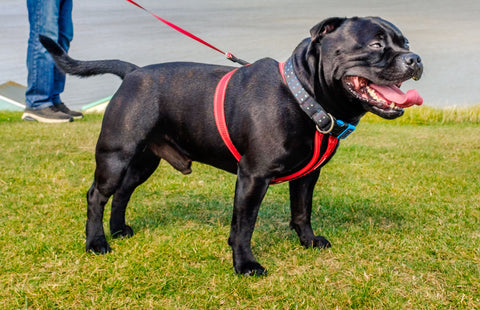For many pet owners, the collar and harness aisle at a pet store can be intimidating. There are so many sizes and measurements, and none of them seem intuitive! Luckily, with a little bit of planning, you can learn how to measure your dog for just about any collar or harness they might need.
What Does A Good Fit Mean, Anyway?

Many folks struggle, understandably so, with a good fit for a collar or harness on their dog. We're afraid of something being too tight and accidentally choking them or restricting their movement; and similarly, we're afraid that they might be able to escape on us! Finding that happy medium is important. Here are a few tips to help:
In most cases, you'll want to be able to slip a finger or two between the straps of a collar or harness and the dog's body. It should be snug but not uncomfortably tight. Think about how your jeans fit before you hit the buffet, and that should give you a good guide.
For dogs with different-shaped heads (looking at you, Greyhounds), or loose skin (oh hey, Sharpeis!), you'll want to take some extra safety precautions. For example, dogs with narrow heads may do best in harnesses instead of collars to minimize the risk of them slipping away. And dogs with loose skin may need a very snug harness or a self-tightening collar like a Martingale collar to avoid escape.
Measuring Your Dog: A Simple Guide
The easiest way to fit your dog for a collar or harness is to follow that brand's guide. Most collars and harnesses will have suggested measurements directly on the package. You may want to do your research online, or come into the store to find the harness or collar you want before going home to take measurements. If you're in the Portland area, you can also bring in your pup and we'd be happy to help with fitting!

If you only want to make one trip, taking one or two measurements will help. If you're wanting a collar, measuring your dog around their neck will give you a rough idea of how large your collar needs to be. Measure where the collar should sit on your dog's neck, as this is the most important place. Be sure to write down the measurement before you come into the store!
The most important measurement you need for a harness is the rib cage measurement, also known as the girth. Measure around your dog's torso, right behind the front legs, for a good estimate of how large a harness will need to be. Ideally, your dog should be standing while you do this so that your measurement will be straight. Use treats and a friend to distract them if your dog is wiggly or impatient.
When you get to the store, you may find that your measurement doesn't quite fit in their categories. That's ok -- just move to the next largest size if you're in between sizes.
Testing Your Collar or Harness Fit

If you're not sure about the fit of your dog's harness or collar, be sure to do some testing before bringing your dog into a high-stress situation. Walk them close to the house, and use a back-up method like a secondary slip collar if you're concerned about escape attempts.
On the other end of the spectrum, you'll want to make sure that your dog's equipment isn't too tight. As you take them on a short walk, keep your eyes peeled for signs that they may be struggling: are they walking with a limp or altered gait because their harness strap is too tight? Adjust if needed. Be sure to bring treats along to make the adjustment process easy and fun.
If you've done your research, made your purchase, and can't get it to fit right or work - that's ok! Give us a call at 503-282-5824, send us an email at support@petsonbroadway.com, or bring your harness to the store if you're in the area. Good luck out there!


